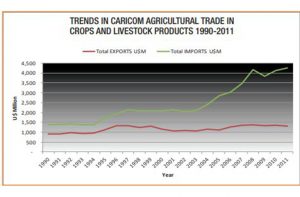— NAREI Director says country well-positioned to capture sizeable share of market
FOR years, Guyana’s ‘potential’ to become the breadbasket of the Caribbean has been under the spotlight and while the rhetoric has outweighed action on this front, the country will be looking to realise its potential in the coming years, with immediate focus on tapping at least 15 per cent of the US$4 billion regional food import bill.
Most of the commodities, which form part of this huge bill, are sourced from the “developed world” while Guyana, a member state of the Caribbean Community (CARICOM), has the potential to supply a sizeable amount of those commodities.
It was reported that 10 commodities – food preparations, wheat, rice, chicken, non-alcoholic beverages, maize, soya bean, sugar and palm oil — account for more than 40 per cent of CARICOM’s food import bill.

Immediately, based on this list, Guyana has the potential to supply rice, sugar and poultry, among many other things. And, there have already been attempts by Government to create a business-friendly environment by removing Value Added Tax (VAT) on the poultry industry and removing VAT and duties on machinery and equipment for mining, forestry, agriculture and manufacturing.
These efforts are seen as part of a broader attempt to making Guyana a hub for business and investments. Chief Executive Officer (CEO), Dr. Peter Ramsaroop even went the “extra mile” by saying Guyana is poised to be the “agriculture capital” of the world.
“We have land mass for many produce and products, so if Guyana can go into large-scale plantation farming, it can easily absorb part of the Caribbean’s food import bill,” said Dr. Ramsaroop, during a recent interview with the Guyana Chronicle.
He is confident that the country is capable of supplying almost anything that the Caribbean has on its bill. But, to do this, there needs to be investments in large-scale projects, such as cattle ranching, mega farms and other big agricultural and agro-processing initiatives.
Persons, in the past, were discouraged from investment in agro-processing and manufacturing, mainly because of the high cost of electricity, something which the new Government has promised to reduce by 50 per cent within the next five years.
“The Government has talked about reducing energy costs by 15 per cent, but you cannot wait until the energy cost comes down… you need to start building… you got to start building and investing now in those areas…. This will help us to capture at least 10-12 per cent of the food import bill, which is a large portion of the country’s GDP (Gross Domestic Product).”
STRESSED BUDGETS
The United Nations Food and Agricultural Organisation (FAO), in October 2013, had said the region’s high food import bill puts pressure on already-stressed Caribbean national budgets, through the need for increased foreign exchange to purchase imports and the fact that higher food prices also require increased social protection programmes.
So, if Guyana is able to tap this bill, it would also mean that the country would be able to supply commodities at reduced costs because the overhead expenses such as shipping would not be exorbitant.
“We need to start positioning ourselves to do this… so we are looking for investors, both foreign and local, who will invest in the cattle industry or open a pasteurisation plant to produce milk at a lower cost,” said Dr. Ramsaroop.
Not just CARICOM, but Guyana also spends millions of U.S. dollars on the importation of milk and other dairy products. So, an investment in this area would be beneficial to the entire region.
This, however, is just one example of Guyana’s potential to become the breadbasket of the Caribbean.
Director of the National Agricultural Research and Extension institute (NAREI), Dr. Odhu Homenauth, in adding his voice to this topic, said Guyana, in preparing to tap the food import bill, would have to thoroughly examine the bill to see what is being imported and where Guyana could have the competitive advantage.
“We have to determine where we have competitive advantage and for which commodities… we also need to ensure that all the trade barriers are lifted… already, we are supplying a lot of commodities to Barbados, Antigua and some of the other small islands,” said Dr. Homenauth during an interview with the Guyana Chronicle on Friday.
Although the country is already a major producer and exporter of rice and sugar, these commodities cannot be ignored in the effort to tap the bill.
“We can also supply rice and sugar to CARICOM… so it is not just fruits and vegetables… we could supply significant quantities,” Dr. Homenauth reasoned.
In addition, the country is capable of exporting and currently exports coconuts, coconut water, watermelons, ground provisions, plantains, pineapples, processed pepper and pumpkin, among other things.
PROVING ITS ABILITY
Guyana is capable of producing a lot more, not just for its people but for the entire region. And, this was evidenced by the country’s ability to remain food secure amidst the novel coronavirus (COVID-19) pandemic, which has toppled economies across the world.
The World Food Programme (WFP) says people are considered food-secure when they have adequate access at all times to sufficient, safe, nutritious food to maintain a healthy and active life. It also lists “food availability,” “food access” and “food utilisation” as pivotal, central planks of food security.
“I would say without any doubt, there was no case where there was a shortage of anything in particular and even with this pandemic, the country, in October surpassed its exports in 2019… this alone is an indication of Guyana’s ability,” said Dr. Homenauth.
For the period January to June 2020 alone, a total of 5,160 metric tonnes of non-traditional agricultural commodities valued at G$1.3 billion or US$6 million were exported from Guyana. This represents a 13 per cent increase when compared to the same period in 2019.
According to a release, of the total non-traditional agricultural exports, 99 per cent (5092 metric tonnes) was shipped via sea, representing a 20 per cent increase from 4267 metric tonnes. This increase is due to a 41 per cent (3036 metric tonnes) and 25 per cent (153 metric tonnes) increase in the export of dried coconuts and coconut water respectively.
Exports of coconut products such as coconut water, coconut oil, and coconut choka have all shown significant increases when compared to the same period in 2019.
The country also saw a 22 per cent increase in regional exports and a 12 per cent increase in extra-regional exports. The major regional export destinations were Barbados, Trinidad, Suriname, and Antigua, while the extra-regional export destinations were the Dominican Republic, USA, Canada, and France.




.png)









